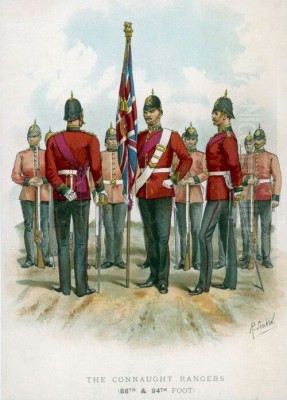
Richard Simkin stands as a significant, if sometimes overlooked, figure in the realm of British military art. Active during the zenith of the British Empire, from the latter half of the 19th century into the early 20th century, Simkin dedicated his prolific career to meticulously documenting the uniforms, regalia, and activities of the British Army and its colonial counterparts. His work, primarily in watercolour, served not only as a visual record but also as a source of popular illustration, shaping public perception of the military during an era of imperial expansion and frequent conflict. While perhaps not achieving the same monumental artistic acclaim as some of his contemporaries who specialized in grand battle canvases, Simkin's contribution to the specific niche of military costume and type illustration remains invaluable for historians and enthusiasts alike.
Early Life and Emergence as a Military Artist
The precise birth year of Richard Simkin has been subject to some minor historical discrepancies, with various sources citing 1840 or 1850. However, more detailed research, including census records and family accounts, strongly indicates his birth on November 5, 1851, in Herne Bay, Kent, a seaside town in southeast England. He passed away on June 25, 1926, in Aldershot, Hampshire, a town deeply intertwined with the British Army, which seems a fitting final resting place for an artist so devoted to military subjects. His nationality was unequivocally British.
Little is recorded about Simkin's formal artistic training, which was not uncommon for illustrators of his time, many of whom were largely self-taught or learned through apprenticeships in commercial art or publishing. What is clear is that he developed a keen eye for detail and a proficient hand in watercolour, the medium that would define the majority of his output. His career began to flourish in an era when illustrated newspapers and periodicals were booming, creating a demand for artists who could provide accurate and engaging visual content. The Victorian public had a voracious appetite for images of the Empire's military forces, their exotic deployments, and their ceremonial grandeur. Simkin was well-placed to cater to this interest.
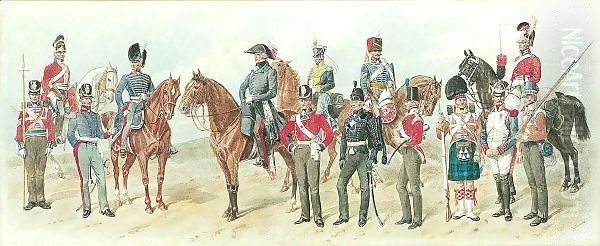
His decision to specialize in military subjects was likely influenced by several factors. The constant presence of soldiers in Victorian Britain, the regular news of colonial campaigns, and the patriotic fervor of the age made military themes highly popular. Furthermore, the intricate and colorful uniforms of the various regiments offered a rich visual tapestry for an artist with an eye for detail. Simkin's work suggests a genuine passion for the subject, extending beyond mere commercial appeal.
Artistic Style, Technique, and Thematic Focus
Richard Simkin's artistic style is characterized by its clarity, precision, and documentary intent. He primarily worked in watercolour, often heightened with bodycolour or gouache to achieve opacity and vibrancy in details like facings, lace, and accoutrements. His figures, while sometimes a little stiff in their formal poses, are rendered with careful attention to the accuracy of their uniforms and equipment. He was less concerned with capturing the high drama and emotional intensity of battle, a domain more famously explored by artists like Lady Butler (Elizabeth Thompson) or the French masters Alphonse de Neuville and Édouard Detaille, and more focused on the systematic depiction of "types" – representative figures of different ranks and regiments.
His compositions are typically straightforward, often featuring one or a few figures against a minimal or suggestive background. This approach kept the focus firmly on the uniform itself. While he did produce illustrations of battle scenes and historical events, his most enduring legacy lies in these detailed studies of military dress. His work covered an extensive period, from the Restoration of the monarchy through to the First World War, showcasing the evolution of British military attire over centuries.
A significant portion of Simkin's oeuvre was dedicated to the British Indian Army and other colonial forces. These depictions are particularly valuable as they document units whose visual records might otherwise be scarce. He captured the unique blend of British military tradition and indigenous dress that characterized these regiments, from the turbans of Sikh soldiers to the distinctive uniforms of Gurkha riflemen. Artists like John Lockwood Kipling (Rudyard Kipling's father) also documented Indian life and crafts, but Simkin's focus was resolutely military.
Major Works and Contributions

Richard Simkin's most famous and extensive series is undoubtedly "Types of the British Army," which was published as monthly supplements to the Army and Navy Gazette. This series, running from approximately 1888 until around 1902, eventually comprised some 176 plates. Each plate typically depicted soldiers from a specific regiment, showcasing their full dress, service dress, or historical uniforms. The series was immensely popular and became a standard reference for uniformologists. The scope was ambitious, covering not only the regular British Army but also yeomanry, militia, volunteer units, and the aforementioned Indian and colonial troops.
Beyond this flagship series, Simkin was a prolific illustrator for various publications and also undertook private commissions. He produced numerous individual watercolours, many of which were reproduced as chromolithographs, making his work accessible to a wider audience. These prints often depicted specific regiments, historical skirmishes, or ceremonial occasions. Examples of his work include detailed renderings of cavalry charges, infantrymen in action, and portraits of officers and men in their distinctive regimental attire. A piece like "10th Jats (Light Infantry)" exemplifies his work on the Indian Army, showcasing the specific uniform details of this renowned regiment.
He also created recruitment posters, which played a vital role in encouraging enlistment, particularly in the lead-up to and during the First World War. These posters often idealized military life, emphasizing camaraderie, adventure, and patriotism, with Simkin's clear and appealing style well-suited to this purpose. His contemporary, Harry Payne, along with his brother Arthur Payne, also produced a vast quantity of similar military illustrations and postcards, often with a slightly more romanticized or anecdotal feel than Simkin's more documentary approach. Another contemporary known for military uniform studies was Orlando Norie, whose style, while also detailed, often featured more dynamic group scenes.
The Context of Victorian and Edwardian Military Art
Simkin worked within a well-established tradition of military art in Britain. The 19th century saw a surge in this genre, fueled by imperial expansion, a series of colonial wars (Crimean War, Zulu War, Boer Wars, campaigns in India, Afghanistan, Sudan, etc.), and a strong sense of national pride. Artists like William Barnes Wollen, Robert Gibb, and Ernest Crofts specialized in large-scale historical battle paintings, often exhibited at the Royal Academy, capturing moments of heroism and sacrifice. Simkin's work, while sharing the military theme, generally operated on a smaller, more intimate scale, focusing on the individual soldier and the details of his appearance rather than the sweeping panorama of battle.
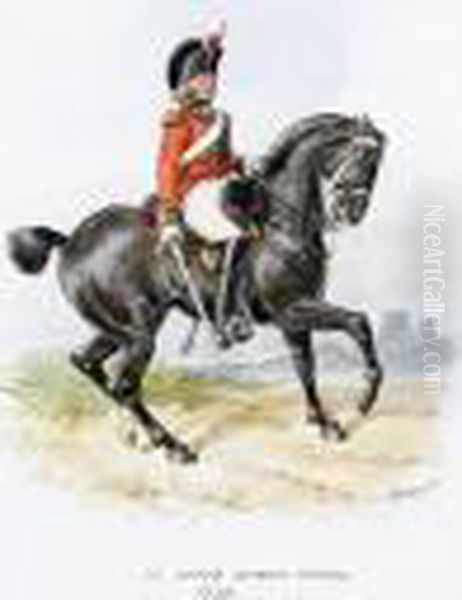
The rise of illustrated journalism, with publications like The Illustrated London News and The Graphic, provided a major outlet for artists depicting current events, including military campaigns. "Special artists" were often sent to the front lines, though many, like Simkin, would also work from photographs, sketches, and written accounts to reconstruct scenes back in Britain. His meticulous approach to uniform detail would have been highly valued by publications aiming for a degree of authenticity.
The tradition of depicting military "types" also had precedents. Earlier artists, such as David Morier in the mid-18th century, had been commissioned to paint soldiers of different regiments for royal collections. By Simkin's time, this practice had become more democratized through affordable prints and publication supplements. His work can be seen as a continuation and popularization of this documentary tradition. The interest in precise military dress was not unique to Britain; French artists like Job (Jacques Onfroy de Bréville) also produced highly detailed and popular illustrations of French military history and uniforms.
Historical Accuracy and Artistic License
While Richard Simkin is generally lauded for the accuracy of his depictions, particularly concerning uniforms, it is important to acknowledge that, like any historical illustrator, he was not infallible. Working across such a vast range of regiments and historical periods, and sometimes relying on secondary sources or incomplete information, occasional errors in detail could creep into his work. Uniform regulations were complex and subject to change, and variations in field dress versus ceremonial attire, or officer versus enlisted man's kit, provided ample room for minor inaccuracies.
However, these occasional lapses do not significantly detract from the overall value of his work as a historical resource. For the most part, his illustrations demonstrate a profound knowledge of his subject and a conscientious effort to achieve accuracy. He often depicted specific historical events, such as the Battle of Ali Masjid or the Battle of Charasiab during the Second Afghan War. In these, the focus remained on the participants and their attire within the context of the event.
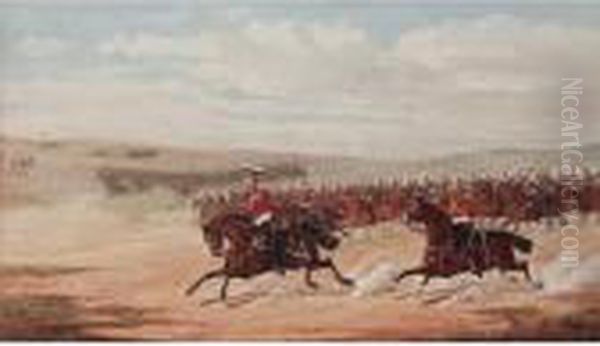
It's also worth noting that the purpose of such illustrations was not solely documentary. There was often an element of idealization or patriotic sentiment. Soldiers were generally depicted as smart, disciplined, and heroic. This was part of the broader cultural narrative of the British military in the Victorian and Edwardian eras. When depicting earlier conflicts, such as the American Revolutionary War (e.g., his portrayal of Bunker Hill), Simkin would have been interpreting events through the lens of late Victorian understanding and artistic conventions, which might differ from the perspectives of artists contemporary to the event itself, such as John Trumbull or even Benjamin West, who, though American-born, became a prominent historical painter in Britain.
Anecdotes, Controversies, and Personal Life
Details about Richard Simkin's personal life remain relatively scarce, which is not unusual for commercial illustrators of his period whose fame rested on their work rather than their personal biography. He appears to have been a diligent and hardworking artist, consistently producing a large volume of work over several decades. His marriage to his wife, Harriet, and their life in Aldershot, a major garrison town, suggest a life lived in close proximity to his primary subject matter. This location would have provided him with ample opportunity to observe soldiers, their drills, and their equipment firsthand, contributing to the accuracy of his work.
In terms of "controversies," his work itself, by modern standards, could be viewed through the lens of colonial history. His depictions of British soldiers in colonial conflicts, while accurate from a uniform perspective, are part of a larger visual culture that often glorified imperial expansion. This is not a criticism unique to Simkin but rather a contextual observation applicable to much of the military art of the period. His art reflected the prevailing attitudes of his time.
The main "controversy," if it can be called that, relates to the minor discrepancies in his birth year in historical records, which has now largely been resolved. Otherwise, his career seems to have been one of steady, professional output rather than dramatic incident. He was not known for radical artistic innovation in the way that, for example, the Impressionists were in France, or even British contemporaries like James McNeill Whistler who challenged academic norms. Simkin operated comfortably within the established conventions of illustrative art.
The Market for Simkin's Work and His Legacy
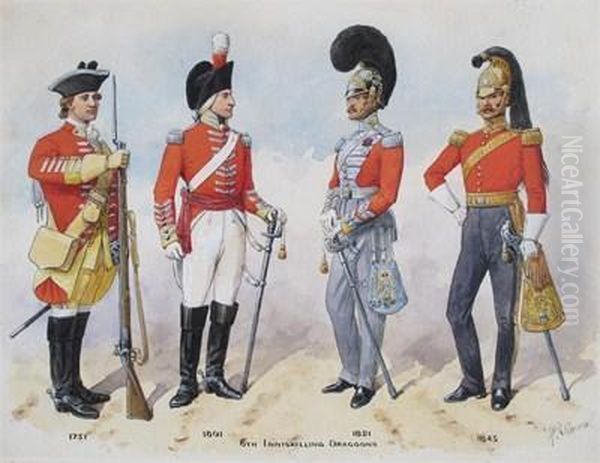
Richard Simkin's original watercolours and the prints made from them have remained popular with collectors of militaria, military historians, and art enthusiasts interested in this specific genre. His original works appear at auction periodically, with prices varying based on size, subject matter, condition, and the specific regiment depicted. Auction houses such as Dominic Winter Auctioneers, Lockdales, and Parker Fine Art Auctions have handled his works. Generally, individual watercolours might fetch prices ranging from a few hundred to occasionally over a thousand pounds sterling, depending on these factors. His chromolithograph prints are more widely available and generally more affordable.
The value of his work lies in its comprehensive nature. Few other artists produced such an extensive visual catalogue of the British Army and its associated forces over such a long period. His illustrations are still used today as references for uniform details, and they provide a vivid glimpse into the appearance of the British soldier during a transformative period in military history.
His legacy is that of a dedicated chronicler. While artists like C. R. W. Nevinson or Paul Nash would later depict the brutal realities of modern warfare in the First World War with a starkly different, modernist sensibility, Simkin's work represents an earlier era's more romanticized, or at least more ordered and colorful, view of military life. His focus on the individual "type" and the precision of uniform detail provides a different but equally important historical perspective. He captured the visual identity of an army that was a cornerstone of a global empire.
Conclusion: An Enduring Visual Record
Richard Simkin's contribution to art history may not be measured in terms of groundbreaking aesthetic innovation, but his importance as a military illustrator and visual historian is undeniable. For decades, he meticulously documented the changing face of the British military, from the scarlet tunics of the Victorian era to the khaki service dress that emerged in the early 20th century. His "Types of the British Army" remains a landmark achievement in the field of military iconography.
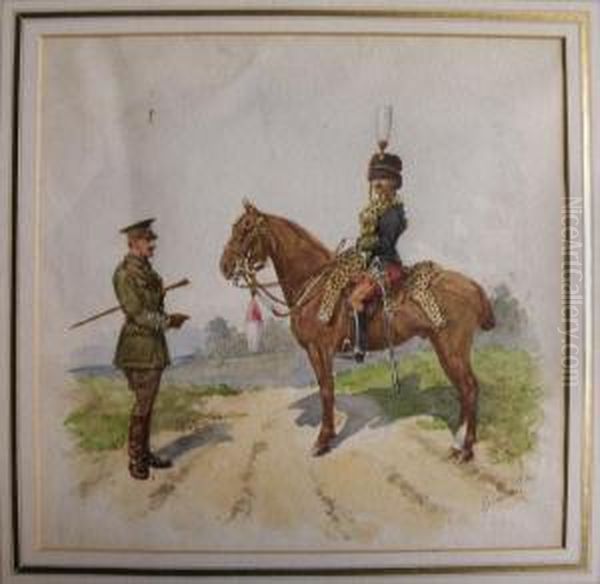
His thousands of illustrations provided an accessible and detailed visual record for his contemporaries and continue to serve as an invaluable resource for researchers, model makers, and anyone interested in British military history. In an age before the widespread use of color photography, artists like Simkin played a crucial role in shaping the public's understanding and image of its armed forces. His dedication to his specialized subject, his prolific output, and the enduring appeal of his detailed watercolours secure his place as one of Britain's foremost military illustrators. His work stands as a testament to a bygone era of imperial power and the distinctive visual culture that accompanied it, offering a window into the world of the British soldier with clarity and enduring charm.